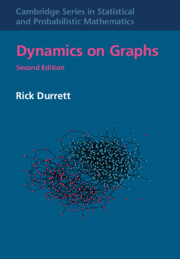
- Coming soon
- Publisher:
- Cambridge University Press
- Expected online publication date:
- September 2025
- Online ISBN:
- 9781009521444

This extensive revision of the 2007 book 'Random Graph Dynamics,' covering the current state of mathematical research in the field, is ideal for researchers and graduate students. It considers a small number of types of graphs, primarily the configuration model and inhomogeneous random graphs. However, it investigates a wide variety of dynamics. The author describes results for the convergence to equilibrium for random walks on random graphs as well as topics that have emerged as mature research areas since the publication of the first edition, such as epidemics, the contact process, voter models, and coalescing random walk. Chapter 8 discusses a new challenging and largely uncharted direction: systems in which the graph and the states of their vertices coevolve.
‘This fully revised book showcases the enormous recent progress made in the field of random graphs and dynamics on them. The chosen topics, including small-world properties, random walks, and interacting particle systems, are carefully picked and well aligned. The author gives a high-level explanation of the proofs of their main results. Omitting the full proofs gives the reader insight in a wide range of topics and the tools of the trade for them, while keeping the book relatively short. Thus, it is an excellent starting point to this exciting field, with dozens of pointers to the literature for more details.’
Remco van der Hofstad - Eindhoven University of Technology
‘Random graph theory (preferential attachment graphs, small-world networks, configuration model, etc.) and interacting particle systems (contact process, voter model, etc.) are currently two of the most important branches of probability theory in terms of mathematics and their applications in epidemiology and sociology. Durrett's book Dynamics on Graphs covers both topics in parallel before merging them in an elegant way along with a rigorous mathematical treatment. The book concludes with the very hot topic of adaptive networks that combine dynamics on the graph and dynamics of the graph, opening the door to future challenging research. Great job!’
Nicolas Lanchier - Arizona State University
 Loading metrics...
Loading metrics...
* Views captured on Cambridge Core between #date#. This data will be updated every 24 hours.
Usage data cannot currently be displayed.